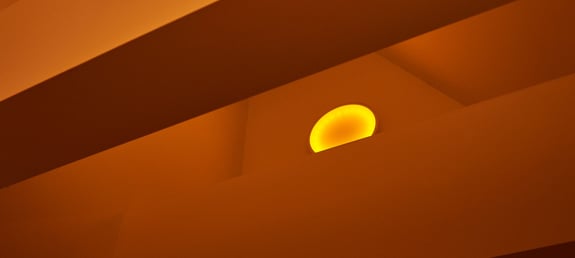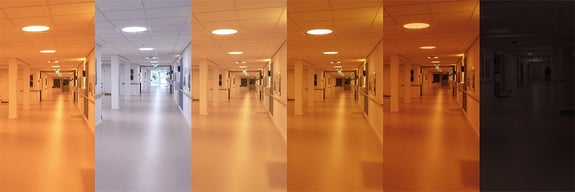
CIRCADIAN LIGHTING
WHY IS LIGHT IMPORTANT?
The human system is designed to derive energy from a balance between light and darkness, with daylight playing a pivotal role. Any disruption in this balance can have a negative impact on our well-being. A prime example is the discomfort many experience when dealing with jet lag. Concentration wanes, focus is lost, and one feels disoriented and fatigued, unable to sleep. This is a result of our body's natural rhythm being thrown off, leading to decreased efficiency and lack of alertness. The same holds true for individuals subjected to night shifts or those who work in darkness throughout the entire workday.
Humans thrive best with a stable circadian rhythm, with daylight during the day and darkness at night. This is crucial in order to ensure the undisturbed functioning of the vital hormone melatonin. Melatonin, an antioxidant, is promoted in darkness and inhibited by daylight.
Today, we spend approximately 90% of our time indoors, which means that the built environment plays a crucial role in the light we are exposed to. However, we rarely consider the impact that light has on our sleep, circadian rhythm, and overall health. For vulnerable patients, maintaining a normal circadian rhythm is particularly important to ensure the best treatment and care outcomes. At the same time, night shift workers are affected by a disrupted circadian rhythm.
WHAT IS CIRCADIAN LIGHTING?
Circadian lighting replicates the beneficial effects of natural light. It automatically adjusts throughout the day, providing a gentle sunrise and strong daylight to establish a healthy circadian rhythm, boost energy, and improve sleep.

WHAT ARE THE ADVANTAGES?
Maintaining a healthy circadian rhythm is crucial for our bodies to thrive and stay well. By ensuring that we receive the right light at the right time, we contribute to fostering both health and well-being. But what are the actual psychological and physical effects that light provides?
Soft lighting in the evening and darkness at night create optimal conditions for a restful night's sleep.
Intense daylight fuels the body and mind with energy throughout the waking hours of the day.
CHROMA ZENIT
Chroma Zenit circadian rhythm light is a non-pharmacological treatment with proven effectiveness. The light is based on a clinically documented light protocol tailored to diagnoses, behavior, and departmental needs - developed in collaboration with sleep experts, doctors, and researchers.
WHO BENEFITS FROM CIRCADIAN LIGHTING?
Everyone needs a good and stable circadian rhythm to thrive and support their health. Circadian lighting are beneficial for anyone who spends the majority of their day indoors, especially those who experience imbalances in their sleep-wake cycle or need to regulate their circadian rhythm. The healthcare sector has a particular need for these lights. Here are some of the groups who will particularly benefit from circadian lighting:
Circadian lighting is effectively used in the treatment of psychiatric patients who struggle with settling down in the evening and achieving a restful and steady sleep. Additionally, the light can be tailored to meet individual patient's needs for stimulation as part of their treatment.
- Unlike conventional lighting, circadian lighting supports the body's natural rhythm, promoting health and well-being while providing visually pleasing light for all types of tasks.

5 PIECES OF ADVICE TO GET STARTED
Choose a system that is tailored to each department and patient group. There is no "one size fits all" lighting solution.


